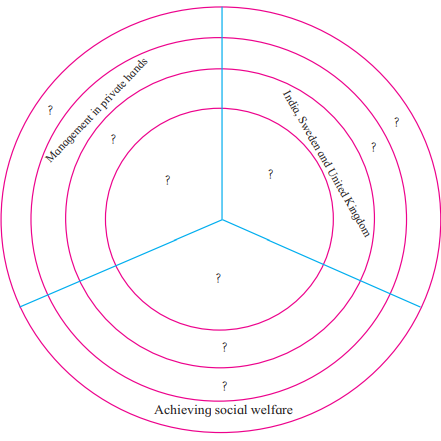Questions Answers For All Chapters – Geography Class 9th
Exercise
Solutions
Q1. Explain the types of economies by filling correct information in the place of questions in the circle.
Capitalistic Economy:
- Ownership and management? Private individuals own and manage production.
- Main aim? To earn maximum profit.
- Examples? Germany, Japan, USA.
Socialistic Economy:
- Ownership and management? The government controls production for society.
- Main aim? To achieve social welfare.
- Examples? China, Russia.
Mixed Economy:
- Ownership and management? Both private and public sectors coexist.
- Main aim? Balance between profit and social welfare.
- Examples? India, Sweden, UK.
Q2. Give an explanation:
(1) Economy begins at home.
- Economy begins at home as it involves managing income and expenditure, reflecting broader economic principles. This mirrors the Greek term ‘oikonomia,’ meaning family management. Personal budgeting lays the foundation for understanding economics.
(2) India’s economy is of mixed type.
- India’s mixed economy blends private and public sectors for profit and social welfare. It balances individual enterprise with government control. This system is also seen in countries like Sweden and the UK.
(3) On the basis of economies, we can divide countries into three groups.
- Countries split into capitalistic, socialistic, and mixed economies based on resource management. Capitalistic (e.g., USA) focus on private profit, socialistic (e.g., China) on welfare. Mixed economies (e.g., India) combine both approaches.
Q3. Write the following questions in one line:
(1) To which economic factor is the management of individual or family finances related?
- It is related to income and expenditure.
(2) From which Greek word is the term ‘Economics’ derived?
- It comes from the Greek word ‘oikonomia,’ meaning family management.
(3) In capitalistic economy, to whom does the ownership and management of means of production belong?
- It belongs to private individuals.
(4) What do you mean by globalisation?
- Globalisation means connecting a country’s economy to the world for free trade and investment.
Activity:
(These are suggestions for students to complete as per the instructions.) (1) Obtain information about the contribution of any Indian economist in Economics and present in the class.
- Example: Amartya Sen helped economics by studying poverty and human development.
- (Students can research and present details in class.)
(2) Consider the income and expenditure of your family and make an account sheet for it.
- Example: Income ₹20,000; Expenditure: Food ₹6,000, Transport ₹2,000, Bills ₹2,500, etc.
- (Students should list their family’s actual income and expenses.)


Leave a Reply